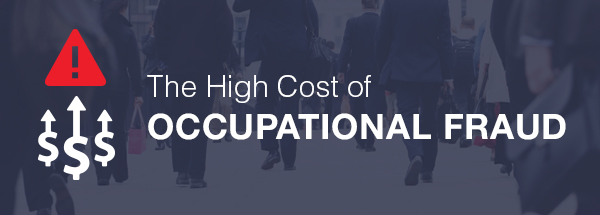2016 ACFE Report Highlights Staggering Cost of Occupational Fraud

A recent report out from the Association of Certified Fraud Examiners (ACFE) confirms a growing and alarming trend – occupational fraud continues to rise, and with it businesses are ravaged by massive costs. The multi-layered impact of occupational fraud affects nearly every industry in every region worldwide – from the US and Canada, throughout Europe, Asia, the Middle East, and into Africa.
It is estimated that approximately 5% of a business’ annual revenues are lost when occupational fraud hits, with many cases never even detected – so the true cost is ultimately unknown. The 2016 ACFE report cites more than $6.3 billion in damages from the occupational fraud cases studied worldwide, from a survey set of 2,410 businesses. Global losses in total are projected at more than $3.7 trillion.
The Sting of a Scheme
Occupational fraud typically covers three categories: asset misappropriations like theft, skimming, or fraudulent disbursements; corruption: including bribery, conflicts of interest, extortion; and financial statement fraud: misreporting as overstatement or understatement. While asset misappropriations are the most common, representing over 80% of cases, the median loss is reported at around $125,000. Comparatively, when financial statement fraud is involved (less than 10% of all cases) the impact can destroy a company, with a median loss of nearly $1M.
Factors that Impact the Size of Loss
When owners or executives are involved, the impact can be even greater, on average more than 10x higher than fraud perpetrated by an employee. Besides the perpetrator’s authority, there are also other factors that affect the cost as well.
Fraud is most often detected in the accounting department (16.6% of the time). Otherwise it is most often found in one of these departments: operations, sales, executive management, customer service, purchasing.
Duration of the scheme also increases the cost, as does how many perpetrators are collaborating. The median duration of discovered cases is around 18 months, with longevity clearly indicating an exponential increase in the size of the loss. The median loss for cases detected after 5 years or more is over $850,000. When one person is involved, the median loss/scheme is $85K vs. 5 or more involved resulting in greater than $630K loss per scheme.
In almost every case, some kind of concealment is involved, making most cases challenging to detect. Sometimes it is the most trusted employee that is a partner, good friend, or family member who is the perpetrator, making it even harder to detect through the conflicting deep bond of trust.
Take Control to Detect and Mitigate Losses
Internal and external controls (or a combination of both) have proven to be reliable tools for detecting incidents and mitigating losses. Research shows that using controls to reduce or eliminate the opportunity to conduct fraud is by far the most effective way to reduce fraud risk. At any stage: prevention, detection, response, or recovery, having systems in place that are promoted and enforced can make the difference in retaining revenues as well as a healthy corporate culture. Systems can include external audits of financial statements, management certification of financial statements and code of conduct. In more than 80% of cases where fraud was ultimately detected, one of those controls (or more) were in place and actively practiced.
To learn more about how to protect your business from the staggering cost of occupational fraud, review the most recent report from ACFE or request a meeting with a Lowers Risk Group consultant and put your prevention program in place today.
ABOUT THE AUTHOR